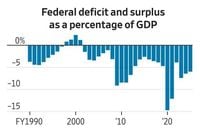The U.S. government has closed the books on fiscal year 2025 with a budget deficit of $1.8 trillion, according to a release by the nonpartisan Congressional Budget Office (CBO) on October 8. Despite a surge in tariff revenues under President Donald Trump’s trade policies, the deficit shrank by only $8 billion compared to the previous year, signaling persistent fiscal challenges even as the economy continues to expand.
For the year ending September 30, 2025, the numbers tell a story of both growth and strain. Federal revenue rose by 6%—an increase of $308 billion—while government spending climbed by 4%, or $301 billion, the CBO reported. The drivers behind these figures are as telling as the totals themselves: record-high interest costs on the national debt, swelling Social Security outlays, and dramatic shifts in Education Department spending.
Interest payments on the public debt soared past the $1 trillion mark for the first time in U.S. history, a milestone that has economists and policymakers alike sounding the alarm. According to the CBO, this record was reached in large part due to rising interest rates and the sheer size of the federal debt, which continues to swell year after year. The figure is unprecedented outside of major crises or economic downturns, and it’s sparking heated debate in Washington over the nation’s fiscal path.
Meanwhile, Social Security spending jumped by $121 billion, an 8% increase over the previous year. This spike was fueled by cost-of-living adjustments and new legislation enacted in January 2025, which allowed certain public sector employees to receive full Social Security benefits. The move, while popular among affected workers, has added significant pressure to an already strained entitlement program.
In stark contrast, the Department of Education saw its spending plummet by $234 billion, a staggering 87% decline from 2024. The bulk of this drop is attributed to changes in student-loan accounting, following an executive order signed by President Trump in March that shuttered many of the department’s functions. The dramatic reduction has been a point of contention, with critics arguing it undermines access to higher education, while supporters claim it reins in runaway federal spending.
But perhaps the most eye-catching development of fiscal 2025 has been the explosion in tariff revenues. Customs duties surged to $195 billion, up from just $77 billion the prior year, as Trump’s trade policies took full effect. After a 90-day pause following their announcement in April, the tariffs began biting in earnest over the summer, targeting dozens of countries and a wide array of goods. Treasury Secretary Scott Bessent has described the increase as a windfall for the Treasury, telling reporters he expects tariff revenue to "grow month over month through the end of the year, potentially heading toward a $500 billion annual pace."
Yet, the sustainability and broader impact of these tariffs remain hotly debated. Bessent himself acknowledged the risks of an adverse Supreme Court ruling that could threaten the revenue stream, calling such a loss "terrible" for the Treasury. Still, he expressed confidence that the administration would find ways to implement similar duties using other presidential authorities if needed.
While tariff receipts have soared, not all revenue sources are on the upswing. Corporate income tax receipts fell by 15% compared to 2024, a decline the CBO attributes in part to Trump’s signature tax and spending plan passed by Congress in July. The legislation allows corporations to take larger deductions for certain investments in 2025, reducing estimated payments. Additionally, a deferral of some revenue from 2023 to 2024 contributed to the lower corporate tax take for 2025.
Despite the jump in tariff revenue and overall federal receipts, the deficit remains stubbornly high. The CBO’s report did not include an official estimate of the deficit as a ratio of gross domestic product (GDP), a key measure of fiscal health. However, based on the agency’s September GDP forecast, the deficit is estimated at 5.9% of GDP for 2025, a slight improvement over the 6.4% ratio recorded in 2024. Bessent and other administration officials have set an ambitious target: reducing the deficit ratio to 3% by 2028, the final year of Trump’s current term.
That goal, however, faces significant hurdles. The ratios seen in recent years, hovering near or above 6%, are historically high outside of periods of crisis or recession. Achieving a dramatic reduction will likely require either substantial revenue increases, major spending cuts, or some combination of both—each a politically fraught proposition.
As for the official figures, the Treasury Department typically releases the final monthly and annual budget numbers in October. However, the ongoing federal government shutdown has cast uncertainty over the timing of the report, and a Treasury spokesperson did not respond to requests for comment on when the data would be published. In the meantime, the CBO’s estimates offer the clearest available window into the federal government’s fiscal position.
The fiscal picture painted by these numbers is, in the words of many economists, "troubling." With the economy still growing, deficits of this size are unusual and raise questions about the sustainability of current policies. The surge in tariff revenue has provided a temporary cushion, but with interest costs and entitlement spending on the rise, the underlying structural challenges remain unresolved.
Looking ahead, much depends on the path of the economy, interest rates, and political will in Washington. The administration’s goal of slashing the deficit ratio to 3% by 2028 will require tough choices and, likely, bipartisan cooperation—a tall order in today’s divided political climate.
For now, the story of fiscal 2025 is one of contrasts: booming tariff receipts, record debt costs, and a deficit that refuses to budge. As the numbers settle and policymakers debate the way forward, the stakes for America’s fiscal future have rarely been higher.
